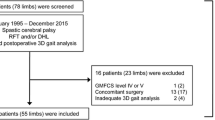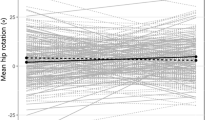Abstract
Background
Stiff knee gait is common among children with ambulatory cerebral palsy (CP). When surgery is indicated, rectus femoris transfer as a primary treatment enhances knee range of motion, reduces time to peak knee flexion, increases peak knee flexion, and reduces toe drag.
Questions/purposes
We determined whether (1) distal rectus femoris transfer improved knee range of motion, time to peak knee flexion, peak knee flexion, and toe drag in children with CP diagnosed with stiff knee gait; and (2) patients in some subgroups (eg, those with relatively high knee range of motion compared with those with low knee range of motion before rectus femoris transfer) had greater improvement in these parameters.
Methods
We retrospectively reviewed gait data from 56 patients (99 limbs) preoperatively, short-term, and long-term. Subgroup analyses were performed to determine whether patients with high knee range of motion relative to those with low or moderate knee range of motion improved differentially after rectus femoris transfer. The minimum followup was 7 years (mean ± SD, 10 ± 2 years; range, 7–13 years).
Results
The mean peak knee flexion increased from baseline to short-term and to long-term followup. Patients with low peak knee flexion had the greatest improvement of peak knee flexion after rectus femoris transfer relative to the moderate and high peak knee flexion subgroups. Similarly, the greatest improvement after rectus femoris transfer for knee range of motion occurred in the low knee range of motion subgroup relative to moderate and high subgroups. Rectus femoris transfer improved mean time to peak knee flexion at short-term and long-term followup compared with baseline. Likewise, there was a decrease in toe drag at short- and long-term after rectus femoris transfer.
Conclusion
Distal rectus femoris transfer selectively improved peak knee flexion, toe drag, and reduced time to peak knee flexion in ambulatory children with CP with stiff knee gait.
Level of Evidence
Level IV, therapeutic study. See guidelines for authors for a complete description of levels of evidence.




Similar content being viewed by others
References
Asakawa DS, Blemker SS, Gold GE, Delp SL. In vivo motion of the rectus femoris muscle after tendon transfer surgery. J Biomech. 2002;35:1029–1037.
Bell KJ, Ounpuu S, DeLuca PA, Romness MJ. Natural progression of gait in children with cerebral palsy. J Pediatr Orthop. 2002;22:677–682.
Chambers H, Lauer A, Kaufman K, Cardelia JM, Sutherland D. Prediction of outcome after rectus femoris surgery in cerebral palsy: the role of cocontraction of the rectus femoris and vastus lateralis. J Pediatr Orthop. 1998;18:703–711.
Goldberg SR, Ounpuu S, Arnold AS, Gage JR, Delp SL. Kinematic and kinetic factors that correlate with improved knee flexion following treatment for stiff-knee gait. J Biomech. 2006;39:689–698.
Miller F. Cerebral Palsy. New York, NY, USA: Springer; 2005.
Miller F, Cardoso DR, Lipton GE, Albarracin JP, Dabney KW, Castagno P. The effect of rectus EMG patterns on the outcome of rectus femoris transfers. J Pediatr Orthop. 1997;17:603–607.
Moreau N, Tinsley S, Li L. Progression of knee joint kinematics in children with cerebral palsy with and without rectus femoris transfers: a long-term follow up. Gait Posture. 2005;22:132–137.
Nene AV, Evans GA, Patrick JH. Simultaneous multiple operations for spastic diplegia. Outcome and functional assessment of walking in 18 patients. J Bone Joint Surg Br. 1993;75:488–494.
Ounpuu S, Muik E, Davis RB III, Gage JR, DeLuca PA. Rectus femoris surgery in children with cerebral palsy. Part I: the effect of rectus femoris transfer location on knee motion. J Pediatr Orthop. 1993;13:325–330.
Ounpuu S, Muik E, Davis RB III, Gage JR, DeLuca PA. Rectus femoris surgery in children with cerebral palsy. Part II: a comparison between the effect of transfer and release of the distal rectus femoris on knee motion. J Pediatr Orthop. 1993;13:331–335.
Reinbolt JA, Fox MD, Schwartz MH, Scott LD. Predicting outcomes of rectus femoris surgery. Gait Posture. 2009;30:100–105.
Rethlefsen SA, Kam G, Wren TA, Kay RM. Predictors of outcome of distal rectus femoris transfer surgery in ambulatory children with cerebral palsy. Pediatr Orthop. 2009;18:58–62.
Saraph V, Zwick EB, Auner C, Schneider F, Steinwender G, Linhart W. Gait improvement surgery in diplegic children: how long do the improvements last? J Pediatr Orthop. 2005;25:263–267.
Saw A, Smith PA, Sirirungruangsarn Y, Chen S, Hassani S, Harris G, Kuo KN. Rectus femoris transfer for children with cerebral palsy: long-term outcome. J Pediatr Orthop. 2003;23:672–678.
Sutherland DH, Santi M, Abel MF. Treatment of stiff-knee gait in cerebral palsy: a comparison by gait analysis of distal rectus femoris transfer versus proximal rectus release. J Pediatr Orthop. 1990;10:433–441.
Wren TA, Rethlefsen S, Kay RM. Prevalence of specific gait abnormalities in children with cerebral palsy: influence of cerebral palsy subtype, age, and previous surgery. J Pediatr Orthop. 2005;25:79–83.
Acknowledgments
We thank Dr Kenneth Rogers and Mr Dustin Sample for the coordination of the materials used in this research and for editorial assistance, respectively. We also thank Ms Joyce Bright for her assistance in gathering the literature used in the preparation of this article.
Author information
Authors and Affiliations
Corresponding author
Additional information
Each author certifies that he or she, or a member of their immediate family, has no commercial associations (eg, consultancies, stock ownership, equity interest, patent/licensing arrangements, etc) that might pose a conflict of interest in connection with the submitted article.
All ICMJE Conflict of Interest Forms for authors and Clinical Orthopaedics and Related Research editors and board members are on file with the publication and can be viewed on request.
Each author certifies that his or her institution approved the human protocol for this investigation, that all investigations were conducted in conformity with ethical principles of research, and that informed consent for participation in the study was obtained.
About this article
Cite this article
Thawrani, D., Haumont, T., Church, C. et al. Rectus Femoris Transfer Improves Stiff Knee Gait in Children With Spastic Cerebral Palsy. Clin Orthop Relat Res 470, 1303–1311 (2012). https://doi.org/10.1007/s11999-011-2215-1
Published:
Issue Date:
DOI: https://doi.org/10.1007/s11999-011-2215-1




